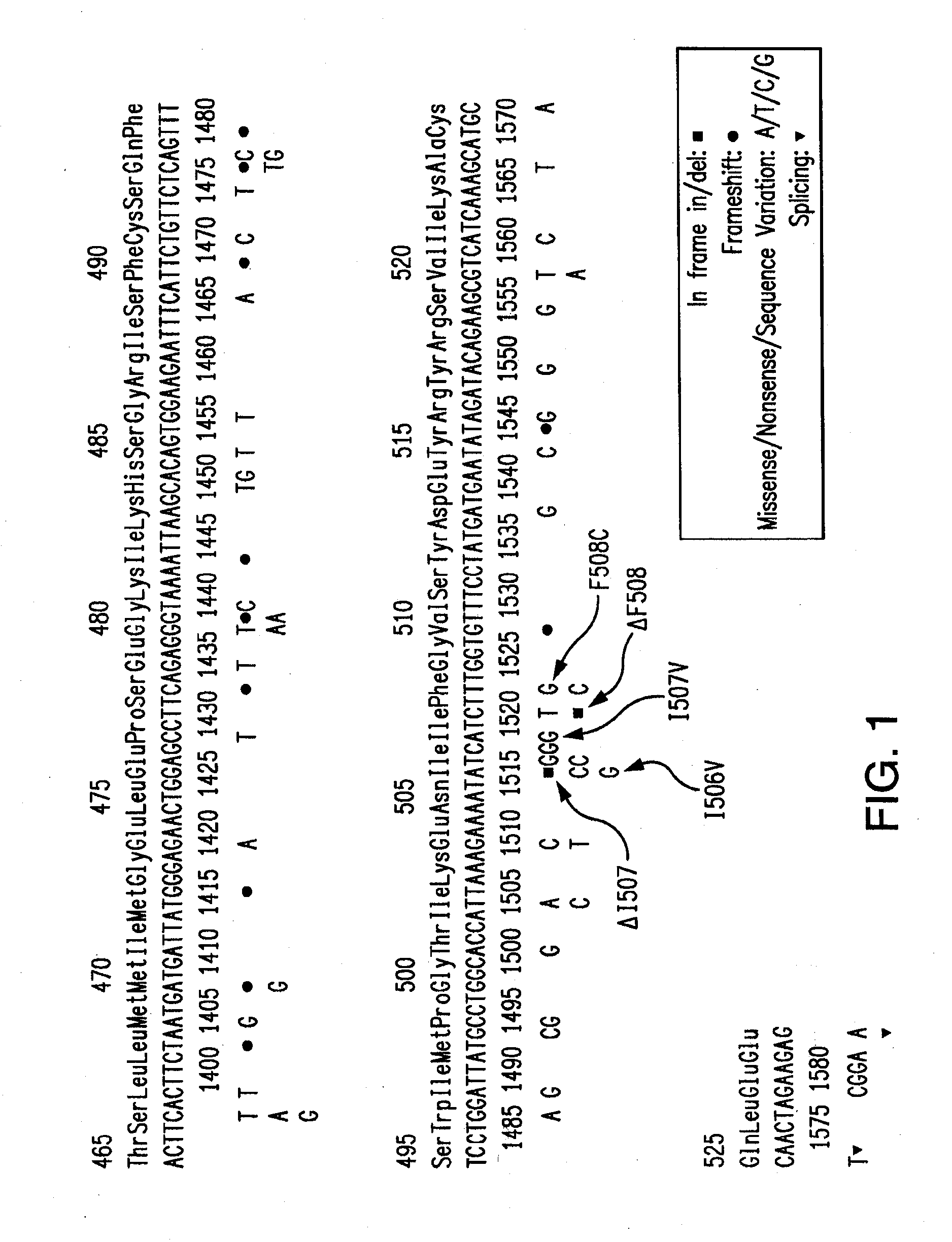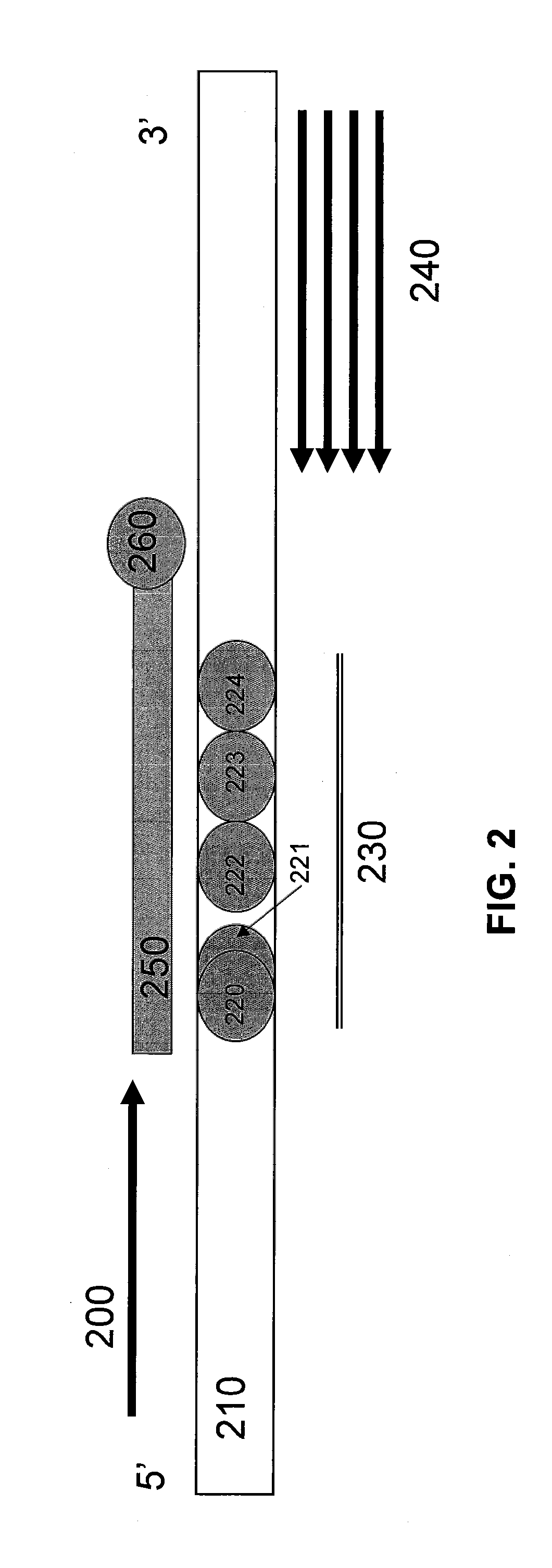Detection of neighboring variants
a neighboring variant and detection technology, applied in the field of detection of neighboring variants, can solve the problems of not being able to distinguish, unable to analyze one sample at a time, and prior techniques for cystic fibrosis (cf) testing using high-resolution thermal melt analysis lacked the ability to discern between benign and disease-causing variants in close proximity, etc., to achieve high-resolution thermal melting curves
- Summary
- Abstract
- Description
- Claims
- Application Information
AI Technical Summary
Benefits of technology
Problems solved by technology
Method used
Image
Examples
example 1
[0091]FIG. 4 illustrates a schematic diagram of primers, probes, and CFTR Exon 10. A forward primer (400), which acts as the limiting primer, extends in the 5′ to 3′ direction of the target nucleic acid having a locus of interest (410) having mutations of interest (420-424) at a locus of interest (430). The mutations of interest (420-424) include benign variants I506V (420), I507V (422), and F508C (424), as well as disease-causing variants ΔI507 (421) and ΔF508 (423). A reverse primer (440), which acts as the excess primer, extends in the 3′ to 5′ direction of the target nucleic acid having a locus of interest (410). Unlabeled probe (450) having a blocker (460) at its 3′ end, has been designed to hybridize to the reverse strand of the target nucleic acid having a locus of interest (410) at the locus of interest (430).
[0092]In one non-limiting embodiment, a primer pair (F2 / R4) that produces a specific amplicon that includes the mutations of ΔI507 / ΔF508 and neighboring benign variants...
example 2
[0095]Biological samples having a locus of interest (see details in Table 1) were incubated with limiting primer (F2), excess primer (R4), and an unlabeled probe (UP3). The two primers were provided in different concentrations along with buffer, dNTPs, MgCl2, LC Green Plus, and polymerase. Parallel mixtures using the same primers and reagents, but a different unlabeled probe (UP4), were also prepared. Each of the mixtures was loaded onto a 96-well plate on a LC 480 and subjected to asymmetric PCR. Initially, the PCRs preceded using the limiting and excess primers to produce small amplicons. In each mixture subjected to PCR, once the limiting primer was exhausted, the unlabeled probe then attached to the locus of interest on a small amplicon in conjunction with the excess primer and PCR continued. It is noted that the unlabeled probes each had a blocker in place so as to not extend during the PCRs.
TABLE 1NA01531CoriellExon 10deltaF508homNA07552CoriellExon 10 / Exon 11deltaF508 / R553XCom...
example 3
[0102]Primers and probes were designed for use in a Cystic Fibrosis American College of Obstetricians and Gynecologists (ACOG) panel. The ACOG panel included the primers and probes described in Examples 1 and 2, above. The sequences of these primers and probes are listed in Table 3 below and details pertaining thereto are listed in Table 4. Forward primers are denominated with the suffix “F#,” reverse primers are denominated with the suffix “R#,” and probes are denominated with the suffix “UP#.”
TABLE 3ExonPrimer or Probe NameSequence 5′-3′ 3Exon 3 G85E F1GCCCTTCGGCGATGTTTTExon 3 G85E R1gatccttacCCCTAAATATAAAAAG 4Exon 4 R117H F3ATGACCCGGATAACAAGGAGExon 4 R117H R2CATAAGCCTATGCCTAGATAAATCGIntronExon 4 621 + 1G > T F2GAGAATAGCTATGTTTAGTTTGATTT 4Exon 4 621 + 1G > T R3gcctgtgcaaggaagtattaIntronExon 5 711 + 1G > T F2GTCTCCTTTCCAACAACCTGAA 5Exon 5 711 + 1G > T R1agtgcctaaaagattaaatcaa 7Exon 7 R334W F2GCACTAATCAAAGGAATCATCCTCExon 7 R334W R2CAGAATGAGATGGTGGTGAAT 7Exon 7 R347P F3CCACCATCTCATTC...
PUM
| Property | Measurement | Unit |
|---|---|---|
| Tm | aaaaa | aaaaa |
| Tm | aaaaa | aaaaa |
| time | aaaaa | aaaaa |
Abstract
Description
Claims
Application Information
 Login to View More
Login to View More - R&D
- Intellectual Property
- Life Sciences
- Materials
- Tech Scout
- Unparalleled Data Quality
- Higher Quality Content
- 60% Fewer Hallucinations
Browse by: Latest US Patents, China's latest patents, Technical Efficacy Thesaurus, Application Domain, Technology Topic, Popular Technical Reports.
© 2025 PatSnap. All rights reserved.Legal|Privacy policy|Modern Slavery Act Transparency Statement|Sitemap|About US| Contact US: help@patsnap.com



